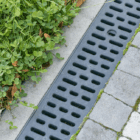It doesn’t matter how strong your asphalt or concrete is. If water sticks around too long, it’ll break it down fast. Cracks, potholes and surface wear often start with poor drainage. In places like Myrtle Beach, where heavy rain is common, water management is just as important as the paving itself. That’s why smart drainage protects pavement investment and keeps your lot or road looking clean and strong for years.
How Drainage Protects Pavement Investment
Standing water seeps into cracks. It weakens the base layer under the surface. Then when the sun dries it out or cold snaps hit, that water expands or erodes, which leads to bigger cracks, soft spots and damage that spreads fast. That’s how a simple puddle can ruin your investment.
Good drainage systems stop that from happening. Here’s how they work:
Curbing
Curbs don’t just mark edges. They direct the flow of water into drains instead of letting it sit on the surface. They also protect the pavement from traffic that might chip away at the edges.
Trench Drains
These drains run across parking lots or roadways and catch water before it collects in low spots. They’re built into the surface and move water away quickly so it can’t settle or cause erosion.
Sloped Grading
When the ground is graded right before paving, water naturally runs off the surface. If the slope is off, water can pool. That’s why grading is one of the most important prep steps in any paving project.
Together, these drainage tools keep water moving, protect the base layers and help your pavement last longer with fewer repairs.
What Happens When You Skip Drainage Planning?
Without a solid drainage plan, problems start fast. You might see puddles, soft spots or sinking areas. Cracks form, edges crumble and the pavement breaks down much sooner than it should. That means more repairs, more money and shorter lifespan for your investment.
It’s not just about saving your asphalt. It’s about saving your time and money too.
Protect Your Pavement from the Ground Up
Whether you’re planning a new project or fixing up an old one, don’t overlook drainage. When drainage protects pavement investment, your asphalt lasts longer, looks better and handles the weather like it should. Want to make sure your lot is built to last? Call Weaver Construction Services and ask how we can build the right drainage solution for your property.
FAQs
1. What kinds of drainage solutions ensure pavement lasts longer and how can drainage protect pavement investment?
Effective drainage solutions include curbing, trench drains, sloped grading, French drains and subsurface drains. These systems move water away from the pavement before it soaks in and causes damage. When water doesn’t sit on or under the pavement it can’t erode the base, crack the surface or weaken the structure over time. That’s how drainage protects pavement investment and keeps your lot from needing costly repairs later.
2. Why is sloped grading important and how does it protect pavement?
Sloped grading means shaping the surface so water flows away instead of gathering. Even a mild slope of one to two percent can prevent puddles and reduce pressure on the pavement. When water flows off the surface it can’t seep in and damage the base. That stops cracks, potholes and erosion before they start and keeps your pavement looking clean and strong.
3. How do trench drains and curbing help with pavement protection and investment value?
Trench drains capture surface water before it pools in low spots while curbing channels water to proper outlets. Together they guide water away quickly and prevent it from weakening the edges or base of the pavement. That reduces structural damage and prevents erosion that can crumble your lot edge. That kind of smart drainage planning strengthens your pavement and protects your investment over the long term.







